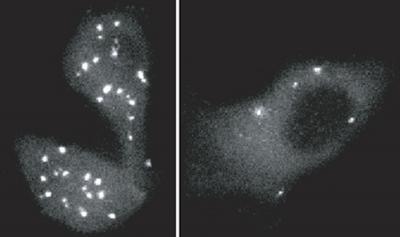Like a climber scaling a rock face, a migrating cancer cell has to keep a tight grip on the surface but also let go at the right moment to move ahead. Chan et al. reveal that the focal adhesion kinase (FAK) coordinates these processes to permit forward movement. The study will be published online April 13 (www.jcb.org) and will appear in the April 20 print issue of the Journal of Cell Biology.
Crawling cancer cells send out extensions called invadopodia. By releasing enzymes that dissolve the extracellular matrix (ECM), invadopodia clear a path for the cell to wriggle through. As they move, cancer cells get traction by temporarily attaching to the ECM through focal adhesions. FAK spurs focal adhesions to disengage, and it is more abundant in metastatic tumors. Whether FAK also regulates invadopodia was unknown.
When Chan et al. removed FAK, breast cancer cells were much less invasive. But to the team's surprise, the FAK-lacking cells sprouted extra invadopodia. The cells also sported large focal adhesions that were particularly sticky. The protein Src serves as FAK's helper. FAK and Src work together to phosphorylate tyrosines in proteins such as paxillin, which then disassemble the focal adhesion. But the team found that in cells missing FAK, the phosphorylated proteins accumulated in invadopodia. Src's localization reflects this difference. In control cells, Src accumulated in focal adhesions. In FAK's absence, Src headed to the invadopodia.

The invadopodia (glowing dots) speckling a cell lacking FAK (left) are rare on a control cell (right).
(Photo Credit: Chan, K.T., et al. 2009. J. Cell Biol. doi:10.1083/jcb.200809110.)
The work suggests that FAK controls movement by balancing the number of invadopodia that create a path for migration and the number of focal adhesions that hold the cell back. The next question, the researchers say, is how FAK and Src integrate these events to promote invasion.


